Trabant
| Trabant | |
|---|---|
|
| |
| Overview | |
| Manufacturer | VEB Sachsenring |
| Production |
1957~1990 (East Germany) 1990~1991 (Germany) 3.7 million produced |
| Body and chassis | |
| Body style |
2-door sedan (Limousine, Saloon) 2-door station wagon (Universal) doorless jeep (Kübelwagen) |
| Layout | FF layout |
| Powertrain | |
| Engine |
500cc two-cylinder two-stroke (1957~62) 600cc two-cylinder two-stroke (1963~1989) 1.0L VW Polo I4 four-stroke (1989~1991) |
| Dimensions | |
| Wheelbase | 2,020 mm (79.5 in)[1] |
| Length | 3,360 mm (132.3 in)[1] |
| Width | 1,500 mm (59.06 in)[2] |
The Trabant /trəˈbɑːnt/ is an automobile that was produced from 1957 to 1990 by former East German auto maker VEB Sachsenring Automobilwerke Zwickau in Zwickau, Saxony.
It is often regarded as a symbol of the defunct East Germany, and of the collapse of the Eastern Bloc in general. The car was known for being uncomfortable, slow, noisy, and dirty. Nevertheless, it was very sought after in East Germany before the fall of the Berlin Wall. It had a hard plastic body, mounted to a single-piece steel chassis (a so-called unibody or monocoque), front-wheel drive, a transversely-mounted engine, and independent suspension, features unusual for the era.
Dubbed a "spark plug with a roof", the Trabant was produced for nearly 30 years with almost no significant changes to its design. 3,096,099 vehicles were produced in total.[3] Older models of the car later became popular among collectors in the United States due to their low cost and the fewer restrictions on importing antique cars. The Trabant also gained a following among car tuning enthusiasts and for use in rally racing and other motorsports.
Overview
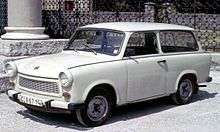
Meaning "satellite" or "companion" in German, the name Trabant was inspired by the Soviet Sputnik satellite.[4][5] The cars are often referred to as the Trabbi or Trabi, pronounced /ˈtrɑːbi/ TRAH-bee in English. Produced without major changes for nearly three decades, the Trabant became the most common automobile in East Germany. The car came to symbolize the country during the fall of the Berlin Wall in 1989, as images of East Germans crossing the border into West Germany were broadcast across the globe.[6][7]
To acquire a Trabant, buyers in East Germany would be placed on a list, with the time taken to receiving one depending on their proximity to Berlin, the capital.[4]
The Trabant had a steel unibody frame with the roof, trunk lid, hood, fenders, and doors made of hard plastic called Duroplast, which was made from recycled materials: cotton waste from the Soviet Union and phenol resins from the East German dye industry.[4][8] This made the Trabant the first car with a body made of recycled material. The material was very durable, such that the average lifespan of a Trabant was 28 years.[8] The use of a fibrous reinforcing material was partially responsible for the misconception that it was made of cardboard – it was dubbed Zwickauer Rennpappe, i.e. "Zwickau racing cardboard". The Trabant was the second car to use Duroplast, after the "pre-Trabant" Zwickau P70, made from 1954–1959.
There were four principal variants of the Trabant:
- the P50, also known as the Trabant 500, produced 1957~1962
- the Trabant 600, produced 1962~1964
- the Trabant 601, produced 1963~1991
- the Trabant 1.1, produced 1990~1991 with a 1,043 cc (63.6 cu in) VW engine
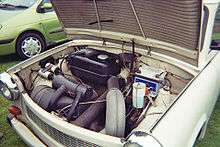
The engine for the 500, 600, and original 601 was a small two-stroke engine with two cylinders, giving the vehicle modest performance. Its curb weight was (~600 kg / 1,100 pounds). At the end of production in 1989, the Trabant delivered 19 kW (26 horsepower) from a 600 cc (37 cu in) displacement. It took 21 seconds to accelerate from 0 to 100 km/h (62 mph) and had a top speed of 100 km/h[9][10] (62 mph).
The engine produced very smoky exhaust and significant air pollution – nine times the hydrocarbons and five times the carbon monoxide emissions of the average European car of 2007. The fuel consumption was 7 l/100 km (40 mpg-imp; 34 mpg-US).[11] Since the engine did not have an oil injection system, two-stroke oil had to be added to the 24-liter (6.3 U.S. gal; 5.3 imp gal) fuel tank[12] every time the car was filled up, at a 50:1 or 33:1 ratio of fuel to oil. Gas stations of the time, in countries where two-stroke engines were common, served premixed gas-oil mixture from the pump. Today, owners carry a container of two-stroke oil in the car for this purpose. Because the car lacked a fuel pump, the fuel tank had to be placed above the motor in the engine compartment so that fuel could be fed to the carburetor by gravity; a trade-off of this design was an increased fire risk in front-end accidents. Earlier models had no fuel gauge; a dipstick was inserted into the tank to determine how much fuel remained.
Best known for its dull color scheme and cramped, uncomfortable ride, the car is an object of "playful ridicule" for many in Germany today, regarded as a symbol of the fall of the Eastern Bloc.[13] Known as a "spark plug with a roof" because of its small size, the car nevertheless gained the public's affection, and has achieved a measure of cult status.[6][7] The design of the car remained essentially unchanged from its introduction in the late 1950s; the last model was introduced in 1964. In contrast, the West German "people's car", the Volkswagen Beetle, received numerous updates such as improvements in efficiency over a similar period.[14]
History
Origins
The Trabant was the result of a planning process that had originally intended to design a three-wheeled motorcycle.[4] In German, a Trabant is an astronomical term to denote a moon or other natural satellite of a celestial body.[15] In its Slavic origin, Trabant has the same meaning as the Russian word sputnik, namely 'companion'.
Full production
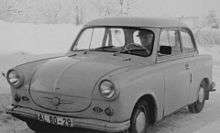
The first of the Trabants left the factory of the VEB Sachsenring Automobilwerke Zwickau in Saxony on 7 November 1957. The Trabant was a relatively advanced car when it was launched in 1958, with front wheel drive, a unitary construction, composite bodywork, and independent suspension. Its greatest downfall was its engine: by the late 1950s many small cars in western countries already used cleaner and more efficient four-stroke engines like that in the Renault. Budgetary constraints and raw materials shortages forced the use of an outdated but inexpensive two-stroke engine in the Trabant. When released, the Trabant was technically equivalent to the West German Lloyd automobile, which had an air-cooled two-cylinder four-stroke engine in a similarly sized vehicle. However, the Trabant was quite a modern vehicle regarding some of its technical solutions: it had a front transversely-mounted engine since the late '50s, and front-wheel drive in an era when many east and west European cars were using rear-mounted engines or front-mounted engines with traction on the rear wheels. In west Germany, for example, there were very few cars with front-wheel drive in the 50's. Volkswagen, German Ford and Opel had adopted front-wheel drive after 1970. Main drawback of the Trabant was the fact that it was produced mainly unchanged, and became heavily obsolete even since the 70's mainly due to its two-stroke engine, therefore its exports in west Europe were limited.
The Trabant's air-cooled two-cylinder 500 cc (31 cu in) (which was upgraded to 600cc in 1962/3) two-stroke engine was derived from a pre-war DKW design, with minor alterations being made throughout the car's production run. The first Saab car had a larger (764cc), water-cooled, two-cylinder two-stroke engine. Wartburg, a GDR manufacturer of larger saloons, also used a DKW engine: a water-cooled three-cylinder 1,000 cc (61 cu in) two-stroke unit.
1958 marked the production of the original Trabant, the P50. This car was the base model of the Trabant series, and even the latest 1.1s shared a large number of interchangeable parts. The 500 cc 18 hp (13 kW) P50 evolved into a 20 hp (15 kW) version in 1960, gaining a fully synchronized gearbox amongst other things, and finally got a 23 hp 600 cc engine in 1962, becoming the P60.
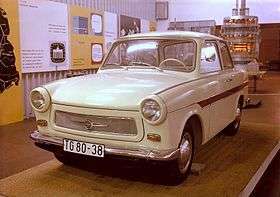
The updated P601 was introduced in 1964. This car was essentially a facelift of the P60, with a different front fascia, bonnet, roof, and rear, whilst retaining the original P50 underpinnings. This model stayed practically unchanged up to its production end, with the most major changes being 12v electrics, coil springs for the rear, and a different dash for the latest models.
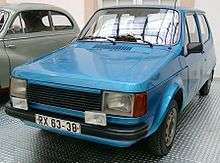
The Trabant's designers expected production to extend to 1967 at the latest, and East German designers and engineers created a series of more sophisticated prototypes through the years that were intended to replace the Trabant P601; several of these can be seen at the Dresden Transport Museum. However, each proposal for a new model was rejected by the GDR leadership due to constant shortages of critical raw materials, which were required in larger quantities for the more advanced designs. As a result, the Trabant remained largely unchanged for more than a quarter-century. Also unchanged was its production method, which was extremely labour-intensive.
Trabant 1100 (also called P1100) was in fact a 601 with a VW Polo engine, of 1.05 liters and producing 45 HP, giving the car some decent performance. It not only had a more modern look, but was far quieter and cleaner than its predecessor. It also had a newer dashboard. The gear lever was floor mounted. It was also equipped with front disc brakes, and the wheel assembly was also borrowed from Volkswagen. It was produced between late 1989 and 1991 in parallel with P601 with its 2 stroke engine. Many parts from older P50 P60 and 601 were compatible with P1100, except engine and transmission, however, some owners did some modifications like trabant P50 with the VW engine.
Late production (1989~1991)
.jpg)

Starting in the summer of 1989, thousands of East Germans loaded their Trabants with as much as they could carry and drove to either Hungary or Czechoslovakia en route to West Germany—the so-called "Trabi Trail." Many of them had to get special dispensation to drive their Trabants into West Germany, as many of them failed to meet West German emissions standards (their pollution was four times the European average).[16]
In 1989, a licensed version of the Volkswagen Polo engine replaced the ancient two-stroke engine, the result of a trade agreement between the two German states. The model, known as the Trabant 1.1, also had minor improvements to the brake and signal lights, a revised grille, and MacPherson struts instead of the leaf spring-suspended chassis. However, by the time it entered production in May 1990, the two states had already agreed to reunification.
By April 1991, 3.7 million vehicles had been produced.[17] It soon became apparent that there was no place for the Trabant in the reunified German economy. The inefficient, labour-intensive production line was kept open only because of government subsidies. Demand plummeted as residents of East Germany preferred second-hand western cars which were more efficient and produced less pollution.
The Trabant production line closed in 1991 and the factory in Mosel (Zwickau), where the Trabant 1.1 was produced, was sold to Volkswagen AG – a move that was seen as ironic given that Volkswagen owns Audi (formerly Auto Union) – which was the original owner of the factory before it was forcibly wound up by the Soviet regime and its directors forced to flee to the West, where the company was re-founded in its current home in Ingolstadt, Bavaria. The rest of the Trabant company became HQM Sachsenring GmbH. Volkswagen has now substantially redeveloped the Zwickau site, which now is a centre for engine production, as well as small scale production of the Golf and Passat.
1990s and beyond
Richard Leiby says the Trabant had become "a symbol of the technological and social backwardness of the East German state."[18] Trabants became well known in the West after the fall of the Berlin Wall when many were abandoned by their Eastern owners after migrating westward. However, unlike many other Eastern European cars of the eastern bloc era – notably the Lada Niva, Škoda Estelle, Polski Fiat, and Yugo – the Trabant was not a strong seller in Western Europe.
In the early 1990s it was possible to buy a Trabant for as little as a few Deutsche Marks, and many were given away. Later, as they became collectors' items, prices recovered, but remain very cheap cars to this day. The popular culture surrounding the Trabant was referenced by the performance artist Liz Cohen in her Bodywork project, which transformed an East German 1987 Trabant into a 1973 Chevrolet El Camino.[19]
In the late 1990s, there were plans to put the Trabant back into production in Uzbekistan as the Olimp.;[20] only a single model was produced.[21]
Former Bulgarian Foreign Minister and Atlantic Club of Bulgaria founding president Solomon Passy owned a famous Trabant, which he used to take NATO Secretaries General Manfred Wörner, George Robertson, and Jaap de Hoop Scheffer for a ride. Passy's Trabant was also blessed by Pope John Paul II in 2002. In 2005, Passy donated the vehicle, which had become a symbol of Bulgaria's NATO accession, to the National Historical Museum of Bulgaria.[22]
In 1997, the Trabant was celebrated for passing the "Elchtest" ("moose test"), a 60 km/h (37 mph) swerve maneuver slalom, without toppling over as the Mercedes-Benz W168 (1997 A-class) infamously did. A newspaper from Thuringia had a headline saying "Come and get us, moose! Trabi passes A-Class killer test".[23]
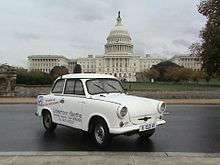
In 2007 the Trabant was brought into the world of diplomacy. Steven Fisher, the Deputy Head of Mission in the British Embassy in Budapest, used a 1.1 – painted as close to British Racing Green as possible – as his diplomatic car.[24][25]
American Trabant owners celebrate the fall of the Berlin Wall with an annual rally in the U.S. capital city of Washington, D.C. called the "Parade of Trabants." The free event, which is sponsored by the International Spy Museum, includes street-side tours in Trabants, rides, live German music, and displays about East Germany is held in early November.[26]
In recent years more Trabants are being imported into Canada and the US. A recent auction from the Bruce Weiner Microcar Museum in Madison, Georgia saw a Trabant P50 and matching Wohnwagen (camper trailer) fetch ~US$25,000.
Car tuning hobby
The very first car tuning attempts can be dated back to the early production times, when a large community of amateur rally drivers fiddled with their "flying guitar picks" (name devised from the plastic material used for several outer parts of its carrossery) to outperform their rivals in their own rally racing category. The car's light weight and front-wheel traction allowed great amount of mishandling on the rally track.
.jpg)
The particularly archaic look and unique two-stroke engine sound of the Trabant has made it a beloved model among car tuners in Central Europe.
Many variations exist, although two major families have been emerged.
The first meticulously preserves the two-stroke engine sound. This is achieved by either tuning the original two cylinder engine for higher performance or using a two-stroke propulsion unit designed for another car (e.g. the 1000 cc Wartburg). Since the Trabant is very lightweight (approx. 750 kg (1,653 lb)), a small increase in engine power can rapidly increase its power-to-weight ratio. A number of enthusiasts have made use of the durable and easily tuned vehicles for rally and other types of racing.
The second family goes beyond the sentimental sound and encompasses a range of modifications. These range from a thorough upgrade of the car's traction to a complete engine replacement, leaving only the body to hide a modern and powerful car underneath (for example, the Sascha Fiss Volkswagen Lupo GTI[27]). Another popular modification is to combine a Trabant with a Japanese superbike engine, like that in the Suzuki Hayabusa (a combination known as Trabusa). Some of these cars have a rated power of over 150 hp (112 kW). The car's light weight gives a power-to-weight ratio of 11 lb/hp (149 W/kg), allowing these vehicles to achieve performance comparable to modern mid-range sports cars.
It has become an established tradition for Trabant fan clubs in central Europe to organize annual meetings to present new tuning modifications and performance accessories for the vehicle.
Planned reintroduction
The Herpa company, a miniature vehicles manufacturer in Bavaria, bought the rights to the Trabant name and showed a scale model of a concept "New Trabi" at the 2007 Frankfurt Motor Show. Plans for production included a limited run, possibly with a BMW engine.[6][7][28] A new Trabant nT model was unveiled at the 2009 Frankfurt Motor Show.[29]
The Trabant nT consortium includes Herpa, German specialized auto parts manufacturer IndiKar, and German automobile engineering company IAV.[30] The group is looking for investment, design, production in the Trabant's original home town of Zwickau[31] and sales "in 2012".[32] The Trabant nT electric car will be equipped with a 45 kW asynchronous motor powered with a lithium-ion battery.[33] The nT will have a 100-mile (160-km) range on a full charge, a top speed of 80 mph (130 km/h), and a cost of €19,600.
Models
- Trabant P50 – later called Trabant 500 (Limousine and Universal (Combi))
-

Trabant P50 Prototype
-

Trabant P50 Limousine later called Trabant 500 Limousine
-
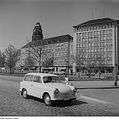
Trabant P50 Universal later called Trabant 500 Universal
-
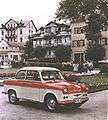
Trabant P50/2 Limousine
-

Trabant 600 Universal
-
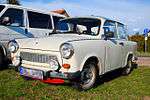
Trabant 601 De Luxe Limousine
- Trabant 600 (Limousine and Universal)
- Trabant 601 Standard (Limousine, Universal)
- Trabant 601 S. (Sonderwunsch – Special Edition) With optional equipment like fog lamps, rear white light and an odometer.
- Trabant 601 DeLuxe. Like the 601 S and additional twin-tone colouring and chrome bumper
- Trabant 601 Kübel. Jeep version with no doors, folding roof, auxiliary heating system, ignition system is RFI shielded.
- Trabant 601 TRAMP. Civilian version of the Trabant Kübel, mainly export to Greece.
- Trabant 601 Hycomat. Made for users with missing or dysfunctional left leg. It had included an automatic clutching system.
- Trabant 800 RS. Rally version
-

Trabant 601 S Universal (with sliding roof)
-
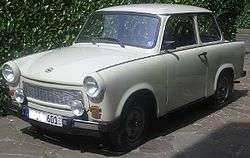
Trabant 601 DeLuxe Limousine
-
Trabant 601 Kübel
-

Trabant 800 RS
- Trabant 1,1 (Limousine, Universal and Tramp (Cabrio))
-

Trabant 1.1 Limousine
-
Trabant 1.1 Universal
Gallery
-
.jpg)
Seven of these eight cars on the State Council of East Germany parking lot in 1986 are a Trabant
-

A Trabant passing the Berlin Wall in 1990
-
A Trabant with all-over advertising, used as a "billboard on wheels" in Prague
-

Outfitted for volunteer fire fighting service
-

This Trabant is technically an official police car, but is only used for public relations purposes.
-

Mural (post-Wende) on the Berlin Wall at the East Side Gallery near Berlin Ostbahnhof
-

Mural on the Berlin Wall at the East Side Gallery featuring Leonid Brezhnev and Erich Honecker riding together in a Trabant (Spring 2002).
-

Trabant modified into a stretch limousine
-

A Trabant 601 with a home-built Trabant trailer.
-

The engine of a Trabant.
-
Trabant hanging upside down from the ceiling. Hard Rock Cafe in Dublin.
See also
- August Horch Museum Zwickau
- Jokes about the Trabant
- Ostalgie
- Soybean Car
- Barkas, another East German car of that era
- Wartburg, another East German car of that era
- Dacia, a Romanian car of that era
- Oltcit S.A., a Romanian car of that era
- FSO Polonez, a Polish car of that era
- FSO Syrena, a Polish car of that era
- ZAZ Zaporozhets, a Soviet car of that era manufactured in Ukrainian SSR
- Lada, a Soviet car of that era manufactured in Russian SFSR
- Škoda, a Czechoslovakian car of that era
- Tatra, a Czechoslovakian car of that era
- Yugo, a Yugoslavian car of that era
References
- 1 2 Legends of the Open Road. Rizzoli International Publications. ISBN 978-88-6130-066-8.
- ↑ World Cars 1978. Herald Books. ISBN 0-910714-10-X.
- ↑ "Trabant Canada". Trabant.ca. Retrieved 2 December 2010.
- 1 2 3 4 James, Kyle (19 May 2007). "Go, Trabi, Go! East Germany's Darling Car Turns 50". Deutsche Welle.
- ↑ Stokes, Raymond G. (2000). "Plastics and the New Society: The German Democratic Republic in the 1950s and 1960s". In Reid, Susan E.; Crowley, David. Style and Socialism: Modernity and Material Culture in Post-War Eastern Europe. Oxford, U.K.; New York, N.Y.: Berg. ISBN 1-85973-239-9. OCLC 898724665.
- 1 2 3 Williams, Adam (6 September 2007). "The 'Trabi' automobile, once a symbol of East Germany, to be revived". International Herald Tribune. Reuters. Archived from the original on 4 December 2008. Retrieved 17 September 2011.
- 1 2 3 "German Firm Plans to Launch Revamped Trabant". Deutsche Welle. 7 September 2007. Retrieved 2 December 2010.
- 1 2 "Special From Germany: Show 402". Scientific American Frontiers. PBS. Archived from the original on 3 July 2015.
- ↑ "BBC". bbc.co.uk. 1 January 2007. Retrieved 14 January 2014.
- ↑ "carfolio.com". carfolio.com. 28 February 2013. Retrieved 2 May 2014.
- ↑ "Trans National Trabant Tour 2007". Transtrabant.cz. Retrieved 2 December 2010.
- ↑ Silk, Bernard (3 May 2003). "Daily Telegraph". London: Telegraph.co.uk. Retrieved 2 December 2010.
- ↑ Hockenos, Paul (7 November 2014). "Berlin Welcomes Back the Trabant, if Only for a Day". The New York Times.
- ↑ Richard Stroup (2003). Eco-nomics: What Everyone Should Know about Economics and the Environment. p. 32. ISBN 978-1-930865-44-0.
- ↑ http://www.interglot.com/dictionary/de/en/translate/Trabant
- ↑ Sebetsyen, Victor (2009). Revolution 1989: The Fall of the Soviet Empire. New York City: Pantheon Books. ISBN 0-375-42532-2.
- ↑ "Trabant".
- ↑ Richard A. Leiby (1999). The Unification of Germany, 1989–1990. Greenwood. p. 185. ISBN 978-0-313-29969-8.
- ↑ Keats, Jonathon (July 2003). "High-Performance Artist". Wired. Retrieved 1 December 2016.
- ↑ "Trabant Clunks Back to Life". Moscowtimes.ru. Retrieved 2 December 2010.
- ↑ "Automobile Industry In Uzbekistan". Retrieved 2 December 2010.
- ↑ "Соломон Паси подари трабанта си на НИМ" (in Bulgarian). Вести. 13 July 2005. Retrieved 13 November 2009.
- ↑ "Petite feat". drive.com.au. 6 May 2005. Retrieved 2 December 2010.
- ↑ "British Deputy Ambassador's ride small and green". Politics.Hu. Retrieved 28 April 2009.
- ↑ Zsolt, Csikós (10 November 2008). "A brit nagykövethelyettes Trabantja ("The British Deputy Ambassador's Trabant")". TotalCar.hu Ltd. Retrieved 5 October 2012.
- ↑ "Sixth Annual Parade of Trabants". International Spy Museum. Retrieved 5 October 2012.
- ↑ Kolb, Michael (15 July 2005). "Trabant P50 von Sascha Fiß: Fliegendes Grau". Axel Springer Auto Verlag GmbH. Retrieved 5 October 2012.
- ↑ Williams, Adam (6 September 2007). "The 'Trabi' automobile, once a symbol of East Germany, to be revived". The New York Times. Retrieved 5 October 2012.
- ↑ "Photo Gallery: Electric Trabant Unveiled at Frankfurt Motor Show". Spiegel Online. 16 September 2009. Retrieved 5 October 2012.
- ↑ "German group develops new Trabant". London: news.bbc.co.uk. 14 August 2009. Retrieved 14 August 2009.
- ↑ Hall, Allan (14 August 2009). "Smoke-belching Trabant to be reborn as electric car". London: telegraph.co.uk. Retrieved 14 August 2009.
- ↑ "The "newTrabi" idea becomes the "Trabant nT" concept car". Trabant nT GmbH. Retrieved 5 October 2012.
- ↑ "Eco Cars: All-electric Trabant NT Gears To Clean 20-year-old Mess". Ecofriend. 17 September 2009. Retrieved 14 October 2009.
Further reading
- Berdahl, Daphne. "'Go, Trabi, Go!': Reflections on a Car and Its Symbolization over Time." Anthropology and Humanism 25.2 (2000): 131-141. online
- Rubin, Eli. "The Trabant: Consumption, Eigen-Sinn, and Movement." History Workshop Journal (2009) 68#1 pp 27–44. online
- Zatlin, Jonathan R. "The vehicle of desire: The Trabant, the Wartburg, and the end of the GDR." German History 15.3 (1997): 358-380. online
- Lisse, Jürgen (2010), Fahrzeuglexikon Trabant (in German) (2. erweiterte ed.), Witzschdorf: Bildverlag Böttger, ISBN 978-3-937496-34-4
- Röcke, Matthias (2011), Die Trabi-Story. Der Dauerbrenner aus Zwickau (in German), Bath: Parragon, ISBN 978-1-4454-6266-0, vormals in zwei Auflagen erschienen im Heel Verlag
- Stiegler, Theo (2007), Der Trabant wird 50! In guten wie in schlechten Zeiten (in German), Dresden: edition Sächsische Zeitung/Saxo’Phon, ISBN 978-3-938325-36-0
External links
| Wikimedia Commons has media related to Trabant. |
| Wikimedia Commons has media related to Trabant vehicles. |
- UK-based official Wartburg, Trabant and IFA owners' club
- Trabant at DMOZ
- TrabantForums TrabantForums.com
- History of the Trabant
- The story behind Trabant
- Sachsenring Trabant site
- IFA Mobile 2-takt Vereniging, de oudste vereniging voor Oost-Duitse auto's
- Trabant history and prospects
- Technical Data and additional Information about Trabant 601.
- Technical details and pictures of the Trabant 601
- British microcar club that welcomes trabant owners and drivers
- Trabant – East Germany's Finest
- Media
- Interactive presentation of Red Pearl Trabant 601z
- Trabant TV ad at Google Videos
- Trabant test drive at Google Videos
- Production of the Trabant car (Final Quality Testing) on YouTube